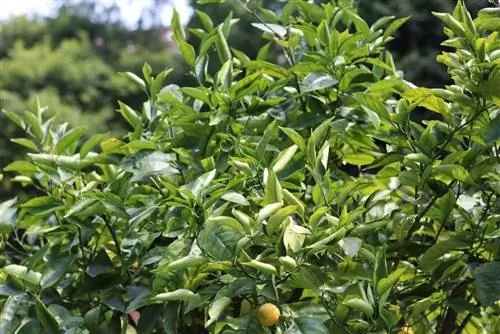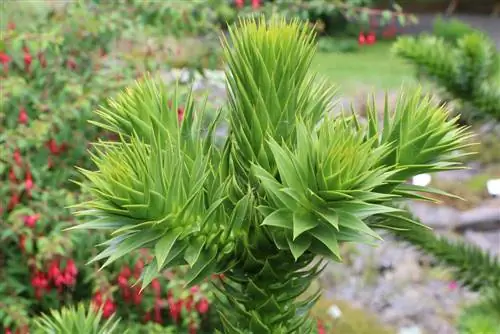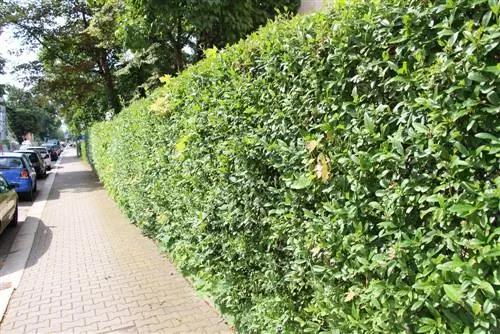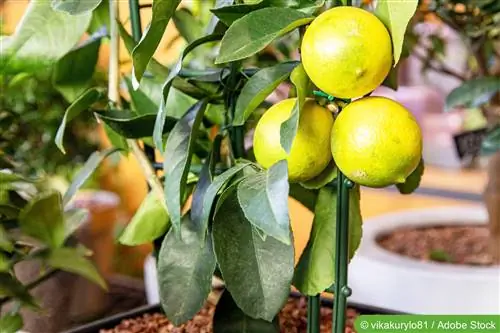- Author admin [email protected].
- Public 2023-12-17 03:39.
- Last modified 2025-06-01 06:48.
Widespread in the Mediterranean, a lemon tree creates a Mediterranean flair on many terraces and balconies. So that you can enjoy your little tree for many years, it is best to think about its needs and preferences before you buy it. Then the care is no longer so difficult and the joy of the first fruits is even greater.
Location
Your lemon tree likes it sunny and warm. To thrive, it needs at least eight hours of sun per day. Neither wind nor too much shade promote its growth and well-being. The lemon tree is then relatively susceptible to diseases or pests and grows poorly. He usually feels very comfortable on a sheltered balcony.
Tip:
The lemon tree is not hardy and is quite susceptible to pest infestation. Only buy it if you can offer it a sunny spot in summer and suitable winter quarters.
Planting substrate
The soil should be nutrient-rich and deep, neutral or slightly alkaline. You probably won't plant your lemon tree outdoors because it's not hardy. But the substrate in the plant pot or bucket should also be well-drained. It is best to use special citrus soil, under no circumstances loamy garden soil. If the substrate is too solid, the roots of your lemon tree will not be able to develop optimally and water absorption will be more difficult. Dry damage could then result.
Plants - step by step:
- Choose a plant pot about 2 to 3cm larger than the root ball
- if not available: drill drain hole
- Create a drainage layer: old pottery shards or large pebbles
- Fill the pot with some well-drained soil
- It is best to use special citrus soil
- Insert lemon tree
- Fill pot with soil
- Press the soil well
- pour well
- It is best not to place it in the blazing sun until it has rooted
Use heavy containers, for example made of clay or ceramic, for both planting and repotting. Then your lemon will not tip over so quickly, even if there is wind. You can weigh down light (plastic) containers with a few stones.
Repotting
The lemon doesn't like to be repotted and takes root poorly. Therefore, you should only consider this if the lemon tree's pot is too small or if you suspect that the tree's roots are rotting. A young lemon tree can then be repotted about every two to three years. If it grows more slowly later, only repot it after five to ten years.
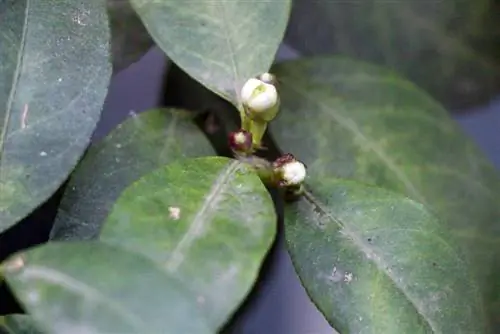
Make sure that you damage the delicate roots of the lemon tree as little as possible when repotting. Remove any rotten and/or soft root parts. You can also carefully cut back the outermost roots of the ball a little. This will encourage the lemon tree to form new roots. However, if large parts of the root ball are rotten or you cut them away because otherwise the tree won't fit in the pot, then your lemon probably won't survive.
Pouring
Lemon trees are quite thirsty, especially when they are in the sun in summer. Water at the latest when the top layer of soil has dried slightly. Ideally, you should always water in the early morning or late afternoon, never in the blazing midday sun. To ensure that your lemon tree really gets enough water, you should always water it thoroughly. Give it enough water so that some of it runs out of the bottom of the planter. This way you can be sure that the bale is well watered. However, the lemon does not tolerate waterlogging, so excess water should always be able to drain easily and, if necessary, be removed from the planter. It is often recommended not to use hard tap water to water citrus plants, but the opposite is the case. Chalky water ensures a good supply of calcium.
Fertilize
You should give the lemon fertilizer regularly, about every one to two weeks, during the growing season. You have the choice between commercial liquid fertilizer or special fertilizer for citrus plants. The latter is particularly well tailored to the needs of your lemon tree. When repotting, mix some humus into the soil or use citrus soil, then the lemon will not need any further fertilizer for a few weeks. It is also important to remember that too much fertilizer does more harm than good. This can easily lead to brown leaf edges or chlorosis. This “yellowing disease” causes the leaves of your lemon tree to turn yellow. This is due to an oversupply or imbalance of nutrients. When using citrus fertilizer and calcareous irrigation water, chlorosis should not occur.
Cutting
Pruning the lemon tree should always be carried out very carefully and moderately. It takes a long time for major cutting errors to “grow out”. However, you can certainly cut the tree into shape. You should remove diseased or dried branches as well as damaged or cross-growing branches. If you let the crown become a little thinner towards the inside, then the leaves and fruits there will also be provided with sufficient light.
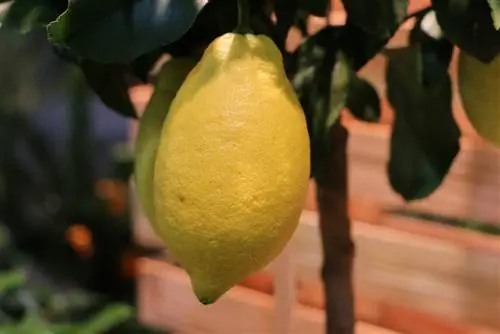
The ideal time to prune the lemon tree depends on the age of the tree and the space available in the winter quarters. Young trees should be pruned before budding in spring. This can happen in spring as well as in autumn. When pruned in autumn, the tree requires less space in its winter quarters. If an older lemon tree tends to become bald, then a more vigorous pruning in late summer is recommended.
Wintering
In the garden, a lemon tree can only overwinter in a mild area if it only freezes rarely and for a maximum of a short time. Even then, it is advisable to move the tree to a protected place. Icy wind and/or cold, wet weather can particularly damage the tree. If you want your lemon tree to go to winter quarters, you have the choice between two different options: cold and warm wintering.
No matter which form you choose, you can slowly stop fertilizing as early as August. In the winter quarters, check regularly whether the plant is getting enough water; the ball should not dry out completely. Before you take the tree outside again, slowly get it used to the sun again.
The cold wintering
For cold wintering you need a cool place with temperatures of 5° to a maximum of 10°C. It doesn't have to be bright here either. However, the tree then loses its leaves. However, it will sprout again in the spring. In cool areas you should only water the lemon tree a little. However, do not suddenly reduce the amount of watering when moving to winter quarters, but rather reduce the amount of watering slowly beforehand.
The warm wintering
The “warm” wintering should be carried out in light and only moderately warm conditions. Remember that your lemon tree will then need more water. Only reduce the amount of watering in the winter quarters and only slightly. Check the substrate regularly for waterlogging. Dry heating air promotes the appearance of pests on many plants. Therefore, the lemon should not overwinter too warmly and with sufficient humidity. If necessary, set up a humidifier.
Propagate
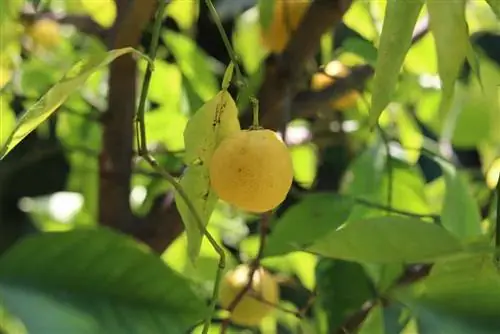
You can propagate your lemon trees by sowing seeds or using cuttings. However, since these cuttings do not always root reliably, you should always plant several. Although sowing is relatively easy, harvesting is only possible after many years. If you want to grow lemons on your windowsill at home, this is possible all year round.
Sowing - step by step:
- Sowing on a nutrient-poor substrate (coconut fibers or soil-sand mixture)
- Press seeds approx. 2 cm deep
- Keep substrate evenly moist
- Avoid direct sunlight
- Germination time at approx. 18 °C: 3 to 6 weeks
- Prick out seedlings when they are 10 cm tall
- slowly get used to direct sunlight
- growing cuttings:
- cut cuttings in early spring, approx. 20 cm long
- remove lower leaves
- Place rube in water, warm and in indirect sunlight
- Rooting after about 3 to 4 months
- Plant cuttings individually
- cut back carefully after about a year (encourages bushy growth)
Diseases & Pests
If you take good care of your lemon tree in a bright and warm place, then no diseases or pests should actually occur. However, due to care errors, chlorosis or yellowing disease, as well as root rot, sometimes occurs. By quickly correcting the errors, the plant can usually be saved.
Pests
that can occur with lemon:
- Aphids
- leather fly
- Bigmouth Weevil
- Scale insects
- Spider mites
Most pests can be controlled relatively well by increasing the humidity and using home remedies. If the infestation is small, simply collecting the small animals is often enough.
When can I harvest the first lemons?
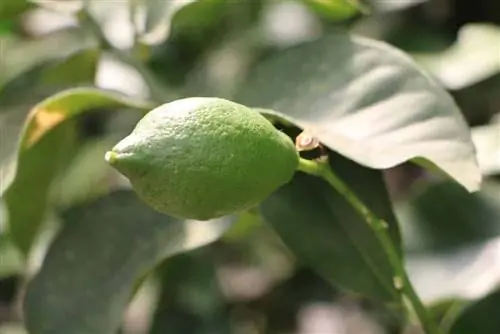
In the Mediterranean region, where the lemon is native, a tree bears its first fruit at the age of five to seven years. With a home-grown tree it will take significantly longer, if it even happens at all. Because lemon trees sometimes bear “barren” fruit. A tree can be grown from their seeds, but it will not bear any fruit. Ideally, however, you can expect the first lemons from a cutting after about seven or eight years. Trees grown from seeds take around ten to 15 years to produce their first fruit.
How old can my lemon tree get?
In nature, a lemon tree can live over 100 years under optimal conditions. However, you shouldn't expect such a long lifespan in your garden. But if you take good care of it, your lemon tree will live to be around 50 years old.
How big will the lemon tree get?
The maximum final size of a lemon tree depends on various factors, most notably the species or variety. The real lemon tree (bot. Citrus Limon) reaches a height of up to seven meters. In the bucket you can expect a size of around two to five meters, depending on:
- Pot size (may limit root growth)
- Sunshine hours per day
- appropriate care (sufficient water and nutrients)

